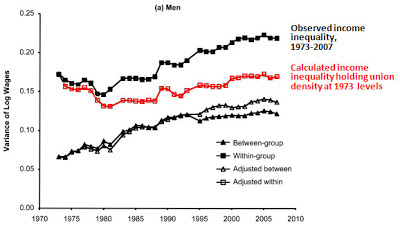Two academics (Western at Harvard and Rosenfeld at the University of Washington) released a paper last year in American Sociological Review which concluded that the decline of unions over the last ~40 years is responsible for up to one third of the concurrent growth in income inequality. See here and here (possibly gated). Here are some more details from Kevin Drum:
The authors use a model that accounts for both individual membership in unions as well as overall unionization rates in specific industries and regions. It also controls for education, age, race, ethnicity, and gender, which allows them to estimate the effect of unionization both between groups (e.g., the evolution of income inequality between high school dropouts and high school grads) and within groups (e.g., the evolution of income inequality within the entire subset of high school grads).
Once their model was in place, Western and Rosenfeld could manipulate their variables to estimate what income inequality would look like if union density had remained at its 1973 level. So what did they find? Answer: Among men, if you account only for the effect of individual membership in unions, it would be about a fifth lower, which agrees pretty well with previous estimates. But if you also account for the effect of unions on surrounding nonunion employers (who often raised wages to compete with union employers and to avert the threat of unionization in their own workplace), the effect is larger: Unionization at 1973 levels would decrease income inequality by a full third. You can see this in the chart below. For intragroup differences (which account for nearly the entire effect of unionization) the top line shows the actual rise of income inequality since 1973, while the red line is a prediction of what it would look like if union density were still at 1973 levels:
Of course, my title might be a bit misleading. One can only say there's an objective case to be made for unions if one wants to reduce income inequality. If you prefer more of a Gilded Age, well, then the unions' continued decline will do the trick.
Postscript: one may worry about corporate profits (and company sustainability) amidst higher wages, but, despite the recession, over the last couple of years corporate profits have actually been at an all-time high.

No comments:
Post a Comment